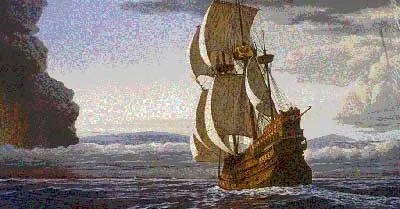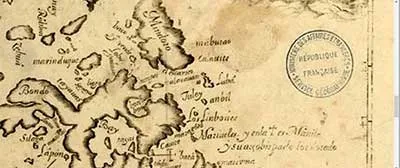Martin De Goite Brings Peace to Warring Natives from Balayan and Nearby Tulayan
“These people declare war among themselves at the slightest provocation, or with none whatever. All those who have not made a treaty of peace with them, or drawn blood with them, are considered as enemies. Privateering and robbery have a natural attraction for them. Whenever the occasion presents itself, they rob one another, even if they be neighbours or relatives; and when they see and meet one another in the open fields at nightfall, they rob and seize one another.1”
Anyone who thinks that the above excerpt is from a contemporary article on the Philippines can be excused because the description does sound regrettably familiar, particularly in impoverished communities. But no, the above excerpt was taken from a 1569 document describing the Philippine Islands and their inhabitants, written by no less than the conquistador and first Spanish governor of the country, Miguel López de Legaspi.
That the document was written in 1569 tells us that he was describing the inhabitants in Cebu and surrounding islands, where he and his fellow conquistadors built a foothold and based themselves for the first five years since their arrival in 1565. That this was true elsewhere, Colonel Martin de Goite and Captain Juan de Salcedo, whom de Legaspi sent in May 1570 to explore the island of Luzon, were soon to find out.
With de Salcedo having caught up with de Goite in the town of Balayan, albeit injured by a poisoned arrow after his party had been ambushed whilst attempting to explore a lake called Bombon, presently Taal Lake, the Spaniards had to ponder their next moves in their goal of reaching Manila.
The Spaniards were detained in Balayan for a period of three to four days as the natives, with whom de Goite had established convivial relations, tried to give him small instalments of impure gold, probably as a tribute. The Spanish expeditionary party had been receiving tributes from towns and villages where they stopped on the way to Manila since sailing from Panay on the 8th of May 1570.
Unable to delay his trip to Manila any longer, de Goite decided to leave Balayan after receiving reassurance from the locals that the promised amount (likely of gold) would be completed and collected on his way back to Panay from Manila. However, local chiefs of Balayan expressed the desire to accompany him and his party on their way to Manila. They were, thus, joined by seven or eight more praus from Balayan.
This had less to do with helping de Goite and company reach their objective and more to gain revenge on the natives of coastal communities along the way, with whom they had a score to settle. These coastal communities were referred to as “Tulayansi” in a narrative of the voyage to Luzon; but other references call the same place “Tulayan” or just “Tulay” or “Tuley.”
Earlier, a vessel from Balayan returning home from Manila laden with merchandise had been driven by a storm to Tulay. Instead of extending hospitality, as might have been expected, to the vessel’s crew, the natives not only stole the goods on the vessel but also killed two members of the crew and displayed their heads on stakes.
A crude 1699 map created by Marcos de Orozco showed a place called “Tuley” off the stretch of coastline past the western peninsula that encloses Balayan Bay as we know it in the present day2. This coastline, called “Tulay” or “Tuley,” was described as being characterised by broad shoals or shallow sandbanks that can even become visible at low tide.
A 1582 document written by Miguel de Loarca gives some clues as to what “Tulay” might be in the present day: “…los pueblos de los vajos de Tuley…” Did he mean “bajas” instead of “vajos;” in which case the phrase, translated, could have meant the lowlands or flatlands of Tuley. This was mentioned as outside and to the east of the “ensenada de Manille” or the cove of Manila, most likely Manila Bay.3
If this was the case, then Tulay, the enemies of Balayan, could have been present-day Calatagan, so named for its flatlands or plains. That said, even parts of the coasts of Lian and Nasugbu are known to have shallow waters.
Indeed, in de Orozco’s crude map, the name “Tulay” is written closer to what ought to be present-day Nasugbu than present-day Calatagan. Perhaps, the entire coastline extending from present-day Calatagan all the way to Nasugbu is what used to be called “Tulay” or “Tulayan.”
At any rate, as de Goite’s Manila-bound party, joined by several praus from Balayan, neared the waters off Tulay, two more praus flying white flags approached. Those on board “declared that they were natives of that coast, and that three towns, which could be seen with the naked eye4” wished to be friends and to pay tributes.
To the displeasure of the natives from Balayan, de Goite accepted the friendship of the people from Tulay. However, he told the two opposing parties that he had come to make friends with everyone. He added,
“that his friends should have no differences between themselves; that, in case they did, it would be right for them to go to the Spaniards for the settlement of them; and that the one breaking with the other would be considered as enemy of the Spaniards.”
Both parties agreed to abide by de Goite’s decision, even if obviously the theft of Balayan’s merchandise and killing of its men had to be left unavenged. The master-of-camp instructed the natives from Tulay to prepare the tribute they promised so that he might pick these up on his return from Manila.
The Spaniards, wary of the shallow waters of the shoal and probably anxious to push on to Manila after hearing from the natives that it was so close, stayed only overnight off Tulay before pushing on early the next day to attain the objective of their expedition.
2 Planta de las islas Filipinas by Marcos de Orozco la Tallo, online at Europeana Collections
3 Relacion de las Yslas Filipinas by Miguel de Loarca, 158, published in the Blair and Robertson series “The Philippine Islands Volume V: 1582-1583”
4 This excerpt along with other details of de Goite’s and de Salcedo’s trip to Luzon are from an unsigned document entitled “Relation of the Voyage to Luzon” published in Blair and Robertson’s The Philippine Islands 1569-1576 Volume III; as are other details of de Goite’s and de Salcedo’s trip to Luzon in 1570.


